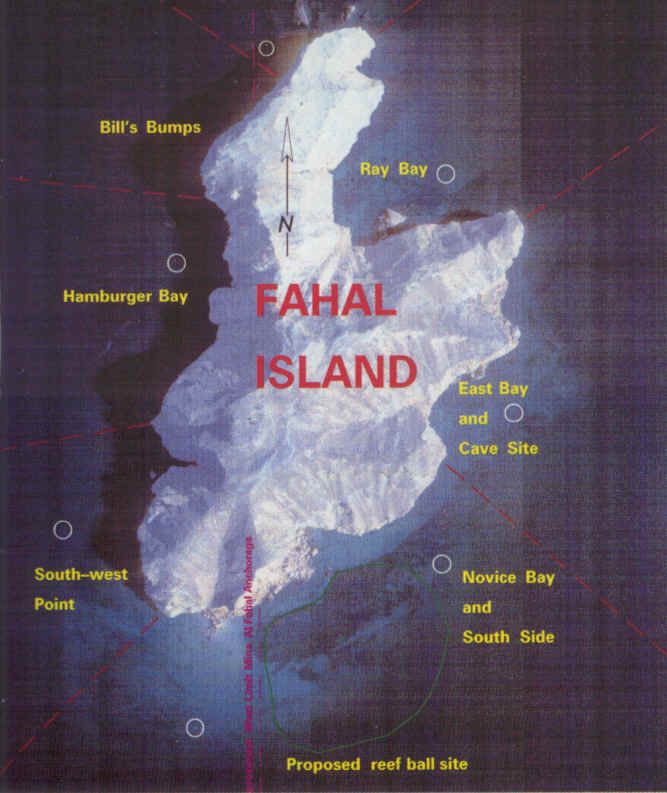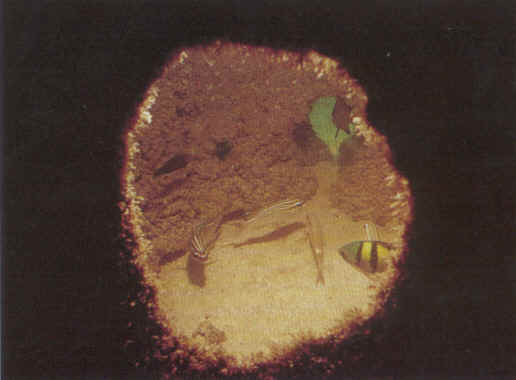
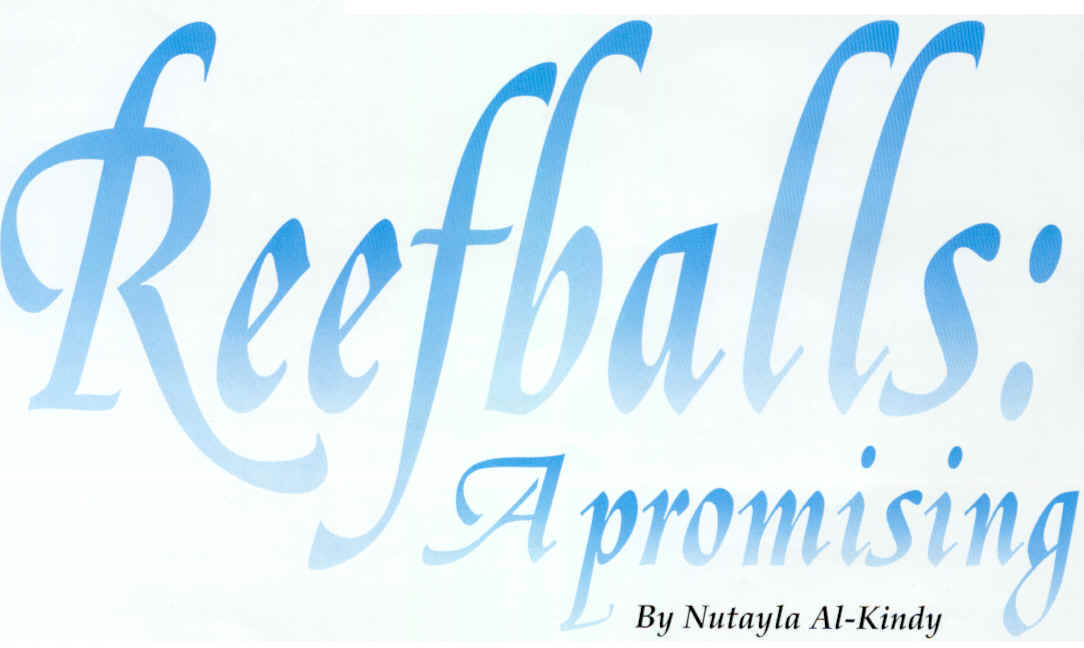

 s coral reefs
continue to decline globally due to damage from human activities, various organisations
around the world are seeking ways to protect them. Objects such as fishing nets and boat
anchors, and indirect processes such as pollutants, sedimentation, temperature increases
and Ultra Violet radiation are mainly the causes for the damage.
s coral reefs
continue to decline globally due to damage from human activities, various organisations
around the world are seeking ways to protect them. Objects such as fishing nets and boat
anchors, and indirect processes such as pollutants, sedimentation, temperature increases
and Ultra Violet radiation are mainly the causes for the damage.In the last edition of PDO News Joppe Cramwinckel and Barry Jupp wrote about a joint project between Petroleum Development Oman (PDO) and the Ministry of Environment and Regional Municipalities (MRME) to test artificial reef materials and structures in the Omani marine environment of Mina al Fahal.
PDO staff and Contractors constructed three modules, each 4 metres square and 1.5 metres high. Two were made of scrap tyres and one of reinforced concrete pipe. The modules were deployed from the barge Fahal on March 12, 1997. Only three weeks after deployment, astonishingly vigorous colonising algae and animal growth on the structures and thousands of juvenile fish were already observed. But initial conclusions are that although tyres form an attractive habitat for fish, they are not suitable for long term reef restoration because of their toxicity and instability.
In another attempt to investigate the restoration and conservation of reefs, a new project is underway on the deployment of what are called 'reef balls', the first ever to be made here in Oman.
The concept was developed by Reefball Development Group Ltd. in Florida, and some 30 Reefball projects have already been initiated around the world.
Reefballs are concrete structures and can he fabricated in various sizes, shapes, hole patterns, hole shapes, hole sizes, surface textures and weights.
At present, Reefballs are available in sizes varying from 0.6 metres in diameter x 0.4 metres high to 1.80 metres in diameter a 1.20 metres high. The equivalent of a large cool box to a structure as lame as a tandoori oven.
They are designed to create stable artificial reef modules, form a hiding place for fish and a foundation for coral growth.
A pilot project has been developed by the Ras Al Hamra Sub-Aqua Club (RAHSAC) for the construction of an artificial reef in connection with the MRME and in close collaboration with Sultan Qaboos University (SQU). The latter will coordinate the scientific activity and ensure the scientific data is properly obtained and analysed.
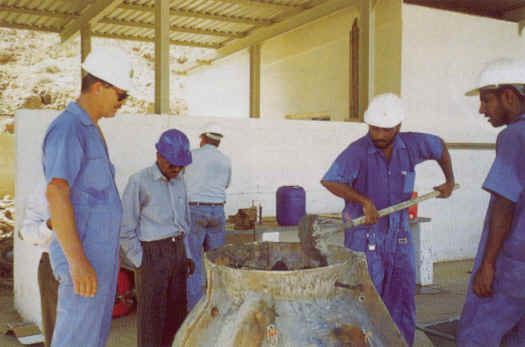
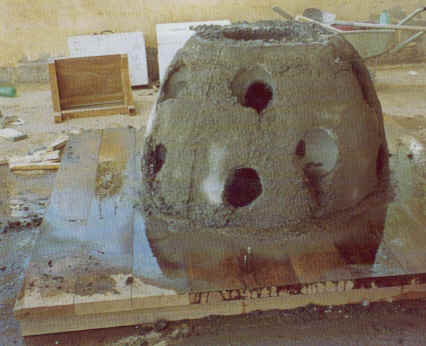
Left, tile concrete mixture is poured into a mould, the little side holes contain file balloons that form the desired tunnels and are later deflated. Above, fresh water is sprayed to roughen tile surface soon after the concrete mixture is released from the mould.
RAHSAC presented the concept to PDO Managing Director Brian Ward for the Company's sponsorship. Brian agreed after studying the idea and seeing potential value in the project. The project is managed by Head of HSE Support Nicolaas Heymans who is also RAHSAC's Environmental officer. Nicolaas underlined the three main objectives of the project:
• To provide fixed monitoring for health management of the MAF bay.
• To test the effectiveness of building new reefs, and restoring the currently damaged ones.
• To increase the fish population.
This includes three main stages: site selection, ball deployment and artificial reef monitoring.
The first stage has been decided upon. The first scientific location is at the South East of Fahal island, which once supported a flourishing assemblage of corals which have been destroyed in the last decade. Other locations have already been identified if the first experiment proves successful.
RAHSAC contacted the Reefball Development Group in Florida for information on their method for making reefballs.
Al Turki laboratories under the supervision of Dr. L.V. Raja tested various mixtures of concrete and chose a mixture which was both strong and would become pH neutral over time.
"Sufficient mixture was made on PDO's marine dock yard for the first three test Reefballs," said Nicolaas. "This concrete was poured into a mould filled with inflated balloons that were later deflated, leaving the desired tunnels. The balls were left for 20 hours to harden slowly so that they did not become brittle when released from the mould.
"Soon after that the outside surface was sprayed with fresh water to expose the gravel buried in the concrete; this gravel and associated surface roughness promotes coral growth. Another ten days were needed for the balls to obtain sufficient strength for deployment."
RAHSAC divers have already deployed three Reefballs in the snorkeling area at the Ras al Hamra bay as a first experiment which also provides an opportunity for snorklers to see what an artificial reef looks like.
The Reefball team expects to install 40 Reefballs over a one year period at the two Fahal locations. They will be deployed in a set of five at each location at four equally spaced periods during October-November, January-February; April-May, and July-August.
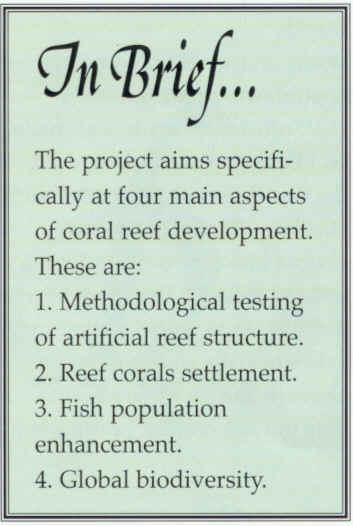 RAHSAC, MRME and SQU divers will thoroughly examine the Reefballs. The team will mark two
surfaces on each ball in order to analyse settlement and growth patterns and the position
of macroscopic sessile organisms such as sponges and soft and hard coral colonies. They
will also follow the growth and mortality of the corals.
RAHSAC, MRME and SQU divers will thoroughly examine the Reefballs. The team will mark two
surfaces on each ball in order to analyse settlement and growth patterns and the position
of macroscopic sessile organisms such as sponges and soft and hard coral colonies. They
will also follow the growth and mortality of the corals.In addition, some Reefballs wilt contain removable algae settlement plates. The SQU divers will collect the plates at regular intervals for assessment of algae settlement, growth pattern as well as for small invertebrates such as worms, barnacles and corals.
Any plate removed will be replaced by another to follow up on the settlement pattern. The samples will he analysed by the SQU and the Marine Science and Fisheries Centre.
SQU will also monitor the temperature at the Fahal Island site which will link the observed pattern of settlement with environmental changes such as tidal cycle, the upwelling cycle and meteorology. This is done by placing a highly sensitive recording thermograph with a 0.001 degree Celsius resolution and a time resolution of two minutes inside one of the Reefballs. Nicolaas added that the reef project has other benefits apart from reef restoration. He said: "Researchers believe that artificial reef can be used to increase the fish stock and so the development and evolution of the fish community will be monitored by video.
"The MRME will advise the local fishermen not to fish at the areas of the experiment after the deployment of the Reefballs. They swill explain to the fishermen the purpose of the project, its potential long term benefits and the reason for the fishing restriction."
The project is also a unique research opportunity for the post graduate students in Marine Biology at SQU and MRME staff. It offers an understanding of a vital stage in the life cycle of reef corals that is not known here in Oman; the reproduction and recruitment pattern of corals.
The pilot project swill he executed over a period of two years. Based on the results of this project, additional artificial reefs on a larger scale could be developed. "We've used the best technology, design and science available to get the best information and methodology. We also have the best expertise to conduct the study and we will not compromise on any aspects which are
required to get the best scientific data out of the project. So even if this project isn't a success, we'll be able to know why it's not successful and make corrections as required," Nicolaas said.
